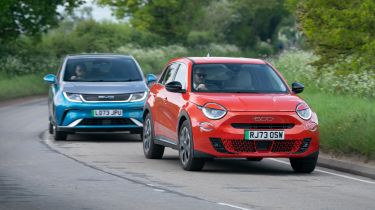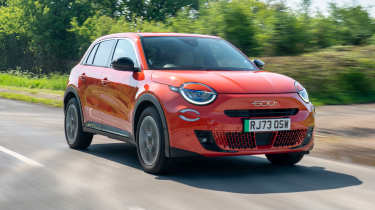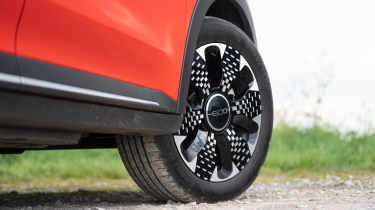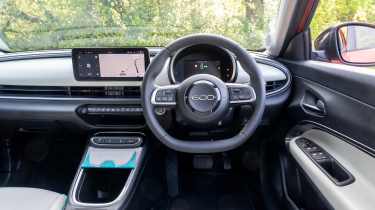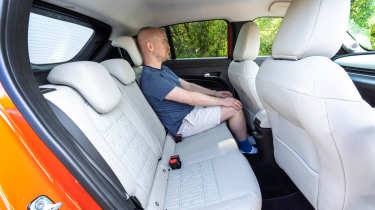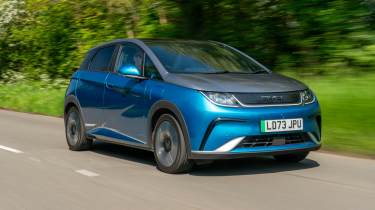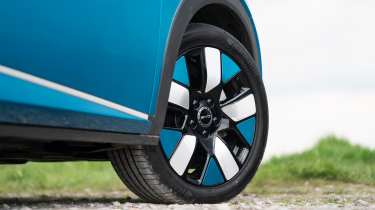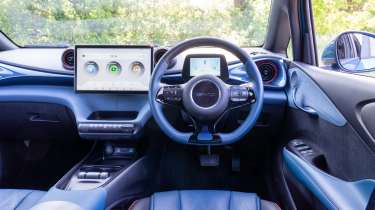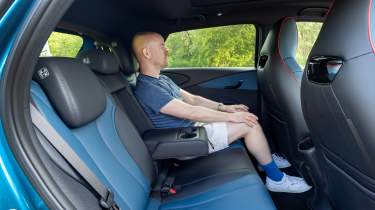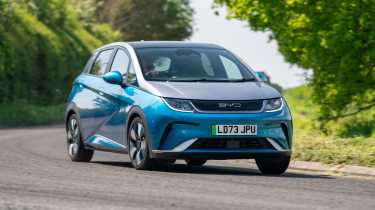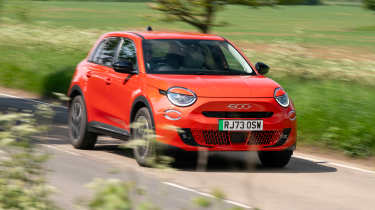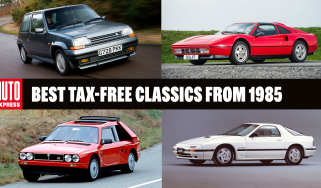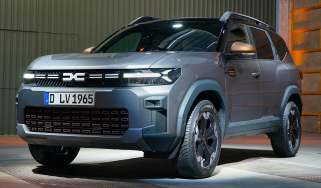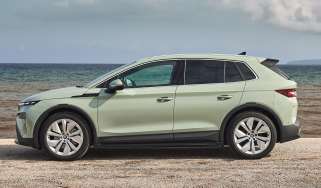BYD Dolphin vs Fiat 600e: which brand makes the best budget EV?
Fiat arrives in the electric SUV class with the 600e – we test it against the BYD Dolphin
When it comes to small cars, few brands have as much experience as Fiat. From dinky city cars, to handsome superminis and even baby sports cars, the Italians have offered them all in the past, often with a dose of charm, desirability and more often than not, fun.
More recent times have introduced compact crossovers to the line-up, and the new 600e is the company’s second fully electric model after the 500. We can almost take the promise of style for granted, but is there substance to go with it? To find out, we’re pitting it against another newcomer to this ever-growing segment.
While the 600e is one of the largest cars in Fiat’s range, the Dolphin is currently the smallest from BYD, a maker that has already shown promise in other sectors with the Atto 3 and Seal. Not only is it the Chinese brand’s smallest car, but it’s also its cheapest, in a class where value for money is a major virtue.
But does it have the sophistication of a car from one of Europe’s giants? We find out by subjecting the pair to our Real World Road Test.
| Fiat 600e La Prima | BYD Dolphin Design | |
| Price: | £36,995 | £31,695 |
| Powertrain: | 1x e-motor, 154bhp | 1x e-motor, 215bhp |
| 0-62mph: | 9.0 seconds | 7.0 seconds |
| Efficiency: | 4.0mi/kWh | 4.0mi/kWh |
| Official range: | 252 miles | 265 miles |
| Charging: | 100kW | 88kW |
Fiat 600e
At first glance, the Fiat 600 range looks quite cheap, with a starting price of £23,975. This, however, is for a petrol model; the EV side of the line-up kicks off from £32,995, with this top-spec La Prima model coming in at £36,995.
Tech highlights
While the rest of Fiat’s range of small cars have emerged from its time as part of the FCA group, the 600e is a car which instead borrows heavily from the French side of the Stellantis empire.
Under the neo-retro bodywork, it uses the same eCMP architecture as a wide range of the Group’s small EVs, including the Peugeot E-2008, DS 3, Vauxhall Mokka Electric and Jeep Avenger. At 4,171mm long, the 600e is about 90mm longer than the Jeep, a touch longer than the DS and Vauxhall, and 133mm shorter than the Peugeot.
Fiat’s designers have done a great job of grafting the looks of its iconic 500 on to a larger compact crossover shape, maintaining the new family face – whose round headlamps are split by a clamshell bonnet – and jelly mould-like side profile.
Power comes from the same set-up found in other eCMP models, so there’s a front-mounted electric motor with 154bhp and 260Nm, and energy is provided by a 54kWh battery, which is big enough to offer a WLTP-tested range of 252 miles. That battery is slightly smaller than some alternatives, but as a result the 600e does weigh less than many rivals – although at 1,595kg it’s still fairly chunky for a compact car.
Safety: Euro NCAP hasn’t yet assessed the 600e, but you’ll need to go for the top-spec La Prima to benefit from the best driver-assist tech that it has to offer. Adaptive cruise control, automatic lane centring (for limited periods) and blind spot detection are exclusive to the flagship.
On the road
While the 600e has the typical EV drawback of a high kerb weight, it still feels compact and nippy to drive. But it’s not particularly remarkable in any one area.
Around town: The 600e does its best work around town. Those compact dimensions and light (if a little slow) steering make it easy to drive on the sort of roads where it’s likely to spend most of its time. The throttle feels a little lethargic in Eco and Normal modes, but sharpens up in Sport mode.
A & B-roads: Sport mode gives access to the 600e’s full 154bhp (it’s available in the other modes, but only when you press the throttle past a kickdown-style step in its travel). We don’t think it’s fair to criticise the outright performance – after all, a nine-second 0 62mph time is more than adequate for a compact crossover – but most fully electric rivals offer stronger straight-line speed.
From a chassis perspective, the 600e is decent to drive. The ride is a little fidgety at low speeds but not intrusively so, and there’s enough give to make it a perfectly relaxing place to be at higher speeds.
The amount of body roll is well judged, giving the driver enough information to feel the tyres loading up – and that’s a good thing, given that the steering offers little in the way of feedback. Grip is also fine, and with a heavy battery mounted low down and between the axles, the balance feels neutral as you approach the limit of the tyres.
Motorway: Refinement is fine at motorway speeds, with both wind and road noise kept at low levels for the class. The ride is smooth, and that more relaxed steering response helps it to feel stable and reassuring at speed. It comes across as a larger car than it really is.
Ownership
Open the doors to our top-spec La Prima test car, and you’re greeted by ivory-coloured seats trimmed in (very convincing) synthetic leather. Turquoise stitching creating the Fiat typeface and 600 logo helps to add a splash of colour, with the colours repeating themselves on the door panels and the large folding cover for the main centre console.
The dashboard is clean and logically laid out – we’re big fans of the individual toggle keys to control the climate functions – but very subtle design tweaks aside, the overall look is very similar to the Jeep Avenger’s dashboard. When Peugeot, DS and Vauxhall all offer completely different configurations on this platform, it’s a shame that a little more individuality wasn’t applied here, too. At least the use of coloured trim finishes does a decent job of masking a cabin that is predominantly finished in rather hard, scratchy plastics.
Fiat has some work to do to improve its customer satisfaction, though. In our 2023 Driver Power survey, it finished 31st out of 32 in the manufacturer ranking, beating only MG. Buyers weren’t impressed with the perceived quality, but it’s worth noting that just 12 per cent of owners experienced a fault of some kind, which contrary to its overall finish, makes Fiat one of the most reliable brands in the survey. A three-year/60,000- mile warranty is provided as standard, which is a little behind the terms of the class best.
Storage: Fiat claims that the 600e’s cabin storage up front is class leading, with a total volume of 15 litres available. A large portion of that comes in the front bin, which is hidden by a magnetic folding cover – a feature also shared with the Jeep Avenger and much like the covers used to protect tablet PCs. It’s a neat idea but it can be a little fiddly when it folds over and sticks to itself. There’s also a deep, open cubby just behind it, and another small covered one beneath the central armrest.
Practicality
The Fiat 600e is a small car overall, and that’s certainly reflected in its interior accommodation.
Rear Space: If you plan to regularly carry adults in the back of your car, then there are better options in this class than the 600e. The main issue is rear kneeroom, which gets tight if a taller occupant sits up front. The Fiat offers similar rear seat space to a Jeep Avenger, but that car is even smaller externally.
Boot: A 360-litre boot is a reasonable volume for a car of this size. The Fiat’s rounded rear end does bring some compromises in practicality, though. The boot opening isn’t particularly large, and the load lip is very high.
When the seats are folded down, that figure increases to 1,231 litres, and though the rear seats don’t fold quite flat, they do drop almost level with the false floor.
What to buy?
Which version we’d choose
- Powertrain: On the EV side of things, there’s a solitary electric powertrain to choose from. If you’d still prefer the flexibility of filling up with petrol, then the hybrid powertrain is a much cheaper option – in matching trim, it costs £10,020 less than the EV.
- Trim: The range kicks off with the (Red) trim level. Kit includes LED headlights, rear parking sensors, a 10-inch infotainment screen, cruise control and keyless go. La Prima adds goodies such as a hands-free tailgate, wireless phone charging and front parking sensors, but it costs a hefty £4,000 extra.
- Our choice: We would keep the costs down by going for the (RED) edition.
BYD Dolphin
With every car it’s released so far, BYD has been punchy with its prices. The Dolphin is the most competitive of all, with this range-topping Design model weighing in at £31,695. That’s £1,300 cheaper than even the base 600e, and £5,300 less than the model tested here.
Tech highlights
Take a look at the Dolphin’s basic specs, and it’s hard to see how it can be so much cheaper than its Italian competitor. The body, which falls somewhere between a mini-MPV and a tall hatchback, rather than following the Fiat’s chunky crossover style, is 119mm longer, 47mm taller and 11mm narrower than its rival’s, while its 2,700mm wheelbase is 138mm longer.
Given BYD’s origins as a battery manufacturer, it’s no surprise to see the Dolphin’s wheelbase has been maximised in order to shoehorn a large pack within its footprint. The blade battery offers a capacity of 60.4kWh, which is 6.4kWh bigger than the Fiat’s. However, given the extra weight it adds – at 1,658kg, the Dolphin is officially 63kg heavier than the 600e – that extra capacity only translates into an extra 13 miles of WLTP range.
There’s a more muscular motor to overcome that extra mass though, with an output of 215bhp and 310Nm of torque a significant 61bhp and 50Nm up on its rival. As with the Fiat, it drives just the front wheels. The rest of the Dolphin’s mechanical structure is fairly conventional, with MacPherson-strut suspension up front and a multi-link set-up at the back.
Safety: BYD has chalked up a maximum five-star Euro NCAP rating for the Dolphin, with strong scores across all four categories when it was assessed in 2023. Adaptive cruise, 360-degree parking cameras and blind-spot detection are
all standard, although we would dive into the on-screen menus to turn the lane-keeping assist off before every journey, because it’s very intrusive.
On the road
The Dolphin is undoubtedly comfortable and quick, but it feels a little dull and lethargic to drive, and refinement could be better.
Around town: The Dolphin requires its driver to be a little more measured with their right foot than in the Fiat, because clumsy throttle inputs when pulling out of a junction can quite easily produce a chirp of wheelspin.
Once on the move, it’s clear that the BYD’s ride is much softer than not only the Fiat’s, but many other rivals’, too. It’s really quite comfortable when cruising around town at low speeds.
A & B-roads: A mix of squidgy suspension, above-average weight and very little in the way of feedback through any of the controls means that there’s very little fun to be had when threading the Dolphin along a country road.
The stability control keeps things on an extremely tight leash, so it always feels safe and predictable, but that seems at odds with the car’s sprightly performance; the instant throttle response gives a turn of speed that’s really surprising for this class, and the seven-second 0-62mph time feels entirely believable.
Motorway: At motorway speeds, the BYD lacks a little refinement compared with the Fiat. Road noise in particular is more audible, but there’s also a touch more wind whistle once you reach the national speed limit. That aside, it’s a comfortable place to be, and there’s still plenty of punch as you accelerate up to 70mph on a slip road.
Ownership
In a class where so many alternatives are largely dull and grey inside, our test car’s blue upholstery with red highlights is a refreshing change. It’s a shame, then, that this currently isn’t available to customers, with the only choice on offer at the moment being all black. At least a standard panoramic sunroof bathes the interior with light.
BYD has tried to be a little creative with the interior materials. Much of the dashboard and door panels is covered in a soft neoprene-type material, and even where there is hard plastic, its texture imitates denim, so it doesn’t look so cheap at a distance. A row of toggle switches sits in the centre of the dashboard, but these don’t give full control of the climate system (only specific functions such as maximum window demisting); instead they offer a range of functions, including the hazard-warning switch and drive-mode select.
As with BYD’s larger models, the Dolphin’s front seats have integrated headrests. Some testers found that these forced their heads further forward than is comfortable, which meant that the seat back had to be reclined more than we would like, to compensate. In other words the choice is between little to no shoulder support or a painful neck.
BYD hasn’t yet featured in our Driver Power survey, but a standard six-year/94,000-mile warranty may reassure buyers coming to a brand that is still very new in the UK.
Storage: The floating-effect console means that there are two storage levels between the front seats. The top has an angled shelf to hold a smartphone securely in place while it’s charging, with a pair of cup-holders and another covered storage bin just ahead. Beneath all of that is a longer, open tray for larger items. There’s a further high-level shelf just beneath the touchscreen, and the glovebox is also very large. The only slight criticism we have is that the door bins are fairly shallow.
Practicality
Given that the Dolphin is slightly larger than the 600e, it’s no surprise that it’s more spacious inside. But the BYD really does feel much more accommodating for back-seat passengers than the Fiat.
Rear Space: The Dolphin has greater legroom for occupants in the back to stretch into than the 600e. An almost completely flat floor helps, too, although headroom is very slightly tighter here. The seats are fairly comfortable, and the Isofix child-seat mounts are easy to access through large plastic openings.
Boot: At 345 litres, the Dolphin’s boot is slightly smaller than the Fiat’s. Both cars suffer from a high load lip, but the Dolphin’s is lower, and with the false floor raised, the load point is completely level. There’s a large under-floor storage area, though; more than enough for charge cables and plenty more besides.
What to buy?
Which version we’d choose
- Powertrains: Much like its rival, there’s just one drive option available with the Dolphin. It’s hard to see what more you’d need, though, because the single-motor arrangement gives strong power, torque and efficiency.
- Trim: Below the Design model we’re testing here sits Comfort. It loses the contrast black roof and has a different wheel design, while wireless charging, a panoramic sunroof and tinted rear windows are omitted, but it still gets the huge touchscreen, heated front seats and LED headlights. Yet there’s only £1,500 between the price of the two models.
- Our choice: For minimal extra monthly outlay, the Design version is worth paying for.
Results
Which car comes out on top?
Winner: BYD Dolphin
The BYD Dolphin is by no means perfect. Many rivals offer faster charging times, are more fun to drive and feel more sophisticated from behind the wheel (although comfort is impressive), while the boot is a little on the small side.
However, the Dolphin isn’t exactly bad in any of these areas, and many of our reservations are more than cancelled out by the fact that, as things stands, the Dolphin is an absolute bargain if you are taking out finance.
| Pros | Cons |
| Fantastic value | Road noise |
| Strong performance | Dull handling |
| Smooth ride | Small boot |
| Loads of standard kit | Underwhelming charge speeds |
Runner-up: Fiat 600e
If you lived with each of these two cars for a week or two, our full-star difference in their ratings might seem like a surprise. The Fiat is slightly slower and less smooth over bumps, but it’s more refined and a little more fun to drive.
It’s not quite as spacious inside, but the tech and ergonomics have a small advantage. However, there’s no getting away from the fact that the 600e is significantly more expensive to own over three years.
| Pros | Cons |
| Efficient powertrain | Hefty depreciation |
| More fun than the BYD | Low-speed ride |
| Slick cabin tech | Tight rear seats |
| Physical climate controls | Dolphin is quicker |
Rivals and other options
The Dolphin wins our test, but what else is out there?
- Same class: Citroen e-C4
- Same money: MG ZS EV
- Used: BMW i3
- Used: Kia EV6
- Coming soon: Abarth 600e
The great debate
The Auto Express team have their say…
John McIlroy, editor-at-large: “We’ve now reached the crucial point where EVs undercut similar internal combustion alternatives on price. That PCP figure of £218 for the Dolphin is incredible; a Renault Clio Hybrid Esprit Alpine (still a bargain in our eyes) costs £271 a month on matching terms.”
Richard Ingram, deputy editor: “Considering it’s such an automotive giant, Stellantis is a little behind the curve with its EVs; it needs better tech or lower prices to fight at the front. Its new STLA platform should move a step forward, but the first car to use it, the Peugeot E-3008, hasn’t exactly blown us away.”
Dawn Grant, picture editor: “The Dolphin is cheap on a three-year PCP, but it’s even better over four. Place just a £289 deposit on the Design and you’ll pay £289 for 48 months. With all costs factored in, it only costs £1,500 more to run it for another year – and half of that is down to the rather hefty insurance quote.”
Jordan Katsianis, senior staff writer: “Fiat needs to work out how to reduce the depreciation of its EVs. Contrary to popular belief, many EVs have strong residuals – the BYD proves that, and VW’s ID. Buzz holds its value better than a Porsche 911 – but both the Fiat 600e and 500e are among the worst performers on the market.”
Dean Gibson, senior test editor: “BYD is set to offer buyers an even smaller EV. The Seagull will be 3.78 metres long and use a 39kWh battery (good for 252 miles), but it won’t cost the same £8,000 it does in China when it arrives here in 2025. Whether it’ll try to steal your chips is unknown at this stage.”
Which would you buy? Let us know in the comments section below…
Specs and prices
| Fiat 600e La Prima | BYD Dolphin Design | |
| On the road price/total as tested | £36,995 / £ 36,995 | £31,695 / £ 31,695 |
| Residual value (after 3yrs/36,000) | £14,598 (39.46%) | £ 17,524 (55.29%) |
| Depreciation | £22,397 | £14,171 |
| Annual tax liability std/higher rate | £148 / £ 295.5 | £127 / £ 253.1 |
| Annual elec. cost (10k/20k miles) | £ 715 / £ 1,430 | £ 715 / £ 1,430 |
| Ins. group/quote/VED | 26 / £487 / £ 0 | 33 / £764/ £ 0 |
| 3-year service cost | £349 | £181 |
| Length/wheelbase | 4,171/2,562mm | 4,290/2,700mm |
| Height/width | 1,523/1,781mm | 1,570/1,770mm |
| Powertrain | Front e-motor/lithium-ion battery | Front e-motor/lithium-ion battery |
| Peak power | 154 bhp | 215 bhp |
| Peak torque | 260 Nm | 310 Nm |
| Transmission | Single-speed/fwd | Single-speed/fwd |
| Battery capacity/ usable | 54 / 54kWh | 60.4 / 60.4kWh |
| Boot capacity (seats up / down) | 360 / 1,231 litres | 345 / 1,310 litres |
| Kerbweight/payload/towing weight | 1,595 / 530 / 0kg (Neither car is rated to tow) | 1,658kg / 410 / 0kg (Neither car is rated to tow) |
| Turning circle/spare wheel | 10.5 metres | 10.5 metres |
| Basic warranty (miles)/recovery | 3 yrs (unlimited) / 1 yrs | 6 yrs (94,000) / 4 yrs |
| Driver Power manufacturer position | 31st | N/A |
| Euro NCAP: Adult / child / ped. / assist / stars | NCAP It's yet to be tested, but the most recent Stellantis models tested on this platform have chalked up four-star ratings rather than the full five | 89 / 87 / 85 / 79 / 5 (2023) |
| 0-62mph / top speed | 9.0 secs / 93mph | 7.0 secs / 99mph |
| Auto Express economy(miles/kWh)/predicted range | 4.0 / 216 | 4.0 / 242 |
| Claimed range (WLTP) | 252 miles | 265 miles |
| Charging capability | 7.4 / 100kW | 7.4 / 88kW |
| Charging time | 8hrs 15mins / 30 mins (10-80%) | 9hrs (est) / 29 mins (30-80%) |
| Actual/claimed CO2/tax bracket | 0 / 0g/km / 2% | 0 / 0g/km / 2% |
| Number of airbags / Isofix points | Six / three ISOFIX Unlike the Fiat, the BYD also has a third fixing on the front passenger seat, making it a little more versatility for families | Seven / yes |
| Parking sensors/camera | F&r/yes | F&r / 360 CAMERA BYD's 360-degree camera is fairly sharp on the large screen, which makes it easy to position in tight spots |
| Lane-keep assist / blindspot / AEB | Yes / yes / yes | Yes / yes / yes |
| Climate control/adaptive cruise ctrl | Dual-zone / yes | Dual-zone / yes |
| Leather / heated seats / wheel | Faux / yes | Faux / yes |
| Metallic paint/LED lights | £0 / yes | £0 / yes |
| Keyless entry & go/powered tailgate | Yes / yes | Yes / yes |
| Sat-nav/digital dashboard/USBs | Yes / yes / three | Yes / yes / four |
| Online services/wireless charging | Yes / yes | Yes / yes |
| Apple CarPlay/Android Auto | Yes / yes | Wired / yes |

